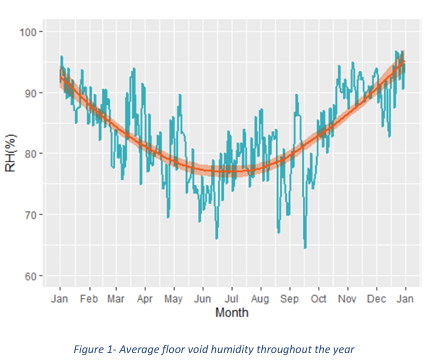Blog 3: Beneath the Surface; Underfloor Expertise for a Smart Retrofit Solution
What the Data Shows, and What It Means
AirEx Floorvent is now installed in more than 4,500 properties and has generated what we believe to be the UK’s largest dataset of underfloor conditions, offering an unprecedented opportunity to understand what happens beneath suspended timber floors.
As a first step in exploring this unique resource, we shared data with Leeds Beckett University, who carried out an independent analysis of Floorvent’s long-term impact on underfloor environment. The study revealed how conditions within the floor void change with external weather and seasonal shifts, and highlighted the difference that responsive, sensor-driven ventilation can make to home performance.
Seasonal patterns and external correlation
The study first confirmed that underfloor humidity closely follows seasonal weather patterns, with relative humidity at its lowest in summer and highest during the cooler months. As the report notes:
“The void humidity trends appear similar to those experienced by the external humidity.”
This relationship is largely driven by temperature differences. Warmer air can hold more moisture, so relative humidity tends to fall in summer even when the absolute amount of moisture is higher.
However, the researchers also observed that conditions beneath the floor do not perfectly mirror those outside, commenting:
“If the void air was perfectly exchanging with the external air, [the difference between internal and external humidity] should be around zero… this is not the case.”
This important finding demonstrates that traditional open air bricks do not always provide consistent or effective ventilation throughout the year.
Lower humidity with Floorvent
The researchers analysed the “before and after” impact of Floorvent on long-term underfloor humidity, using two datasets, one covering winter and another spanning a full year. The key conclusion was that, across the sample, installation of Floorvent appeared to reduce average humidity levels in the floor voids. As the report summarised:,
“Both versions of the analysis therefore suggest that Floorvent can, on average, decrease the relative humidity in floor voids by a small amount.”
While the reduction is modest, it is statistically significant, indicating that responsive, sensor-driven ventilation can improve underfloor conditions while reducing heat loss.
The study suggests this may be linked to the way the system manages airflow:
“The reduction in RH may therefore be due to the algorithm correctly choosing the best times to vent and providing more ventilation during these periods.”
The value of purge ventilation
Rather than allowing continuous airflow, Floorvent enables short, timed bursts of purge ventilation when conditions are most favourable. The Leeds Beckett report suggests this approach is effective:
“Floorvent may actually cause slightly lower humidity levels, on average… Floorvents have been designed to provide more ventilation during periods when conditions are favourable.”
By avoiding periods when outdoor air is cold and damp, the system helps maintain warmer, drier underfloor conditions, supporting both energy efficiency and healthier homes.
The researchers also observed that underfloor temperatures were typically higher in homes with Floorvent, which in turn helps reduce relative humidity even further.
The value of data
Although average humidity levels were lower after the installation of Floorvent, the data also showed that some individual properties recorded higher humidity towards the end of the monitoring period. While this could raise concerns, the researchers noted that:
“the current data suggests these homes would have experienced this increase regardless of the install. The ability of Floorvent to detect these increases could therefore be seen as an advantage, as any potential damp risks can be detected early and corrected before remedial works are required.”
This finding highlights the broader value of smart technologies that not only operate intelligently, but also generate data to support proactive management of property health.
This conclusion highlights the value of smart technologies that provide data on property health as well as operating intelligently.
What it means for housing
The findings of this independent research underline the importance of ventilation that adapts to its environment. By ventilating effectively and at the right time, responsive systems such as Floorvent can deliver better outcomes by aligning airflow with real-world conditions.
In short: don’t ventilate more, ventilate better.
By purging moisture when it helps and retaining heat when it matters, Floorvent supports healthier, more energy-efficient homes; improving comfort, housing quality, and long-term asset performance.


